
BOSE® QC-25 Head-Set
Today, the best solution for Ham Radio in terms of lightness, comfort and audio quality
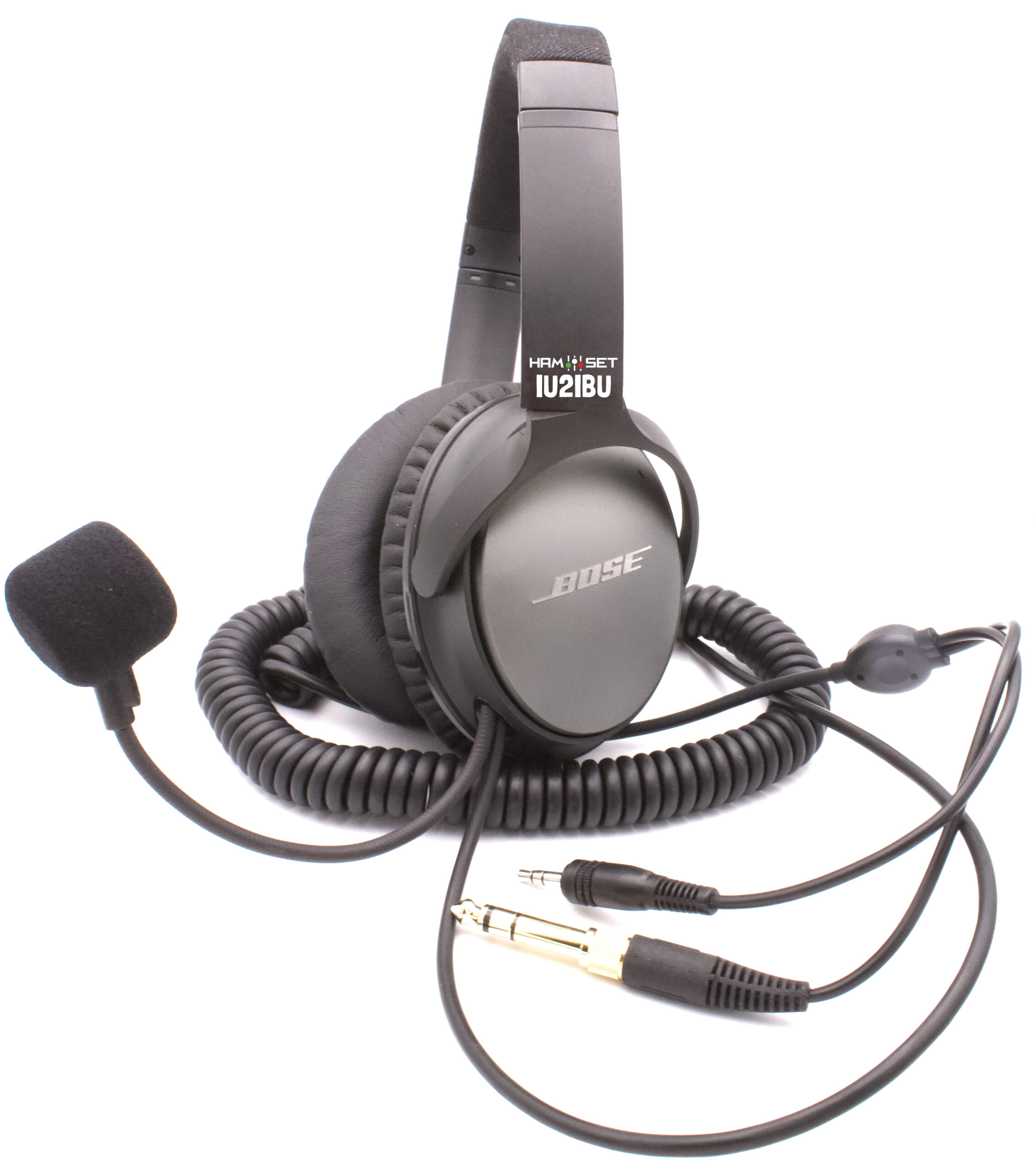
Why Bose® QC25?
Essential, Functional, and Comfortable! The only things that matter when it comes to Ham Radio Accessories.
The Bose® QC-25 Ham-Set is essential because, in addition to the Noise Cancelling System, it does not have circuits that could cause annoying audio feedback, such as Bluetooth. Moreover, the Bose® brand guarantees unparalleled clarity and precision of sound, especially in CW mode.
The Bose® QC-25 Ham-Set is functional thanks to its lightweight boom microphone, which is high-quality and highly compatible with our radio models, enabling operations in all bands and modes. Additionally, it comes with a new RF-proof connection cable that prevents interference even at higher transmission powers.
The Bose® QC-25 Ham-Set is comfortable because you can wear them for the entire 48 hours of a contest without experiencing the slightest ear discomfort!
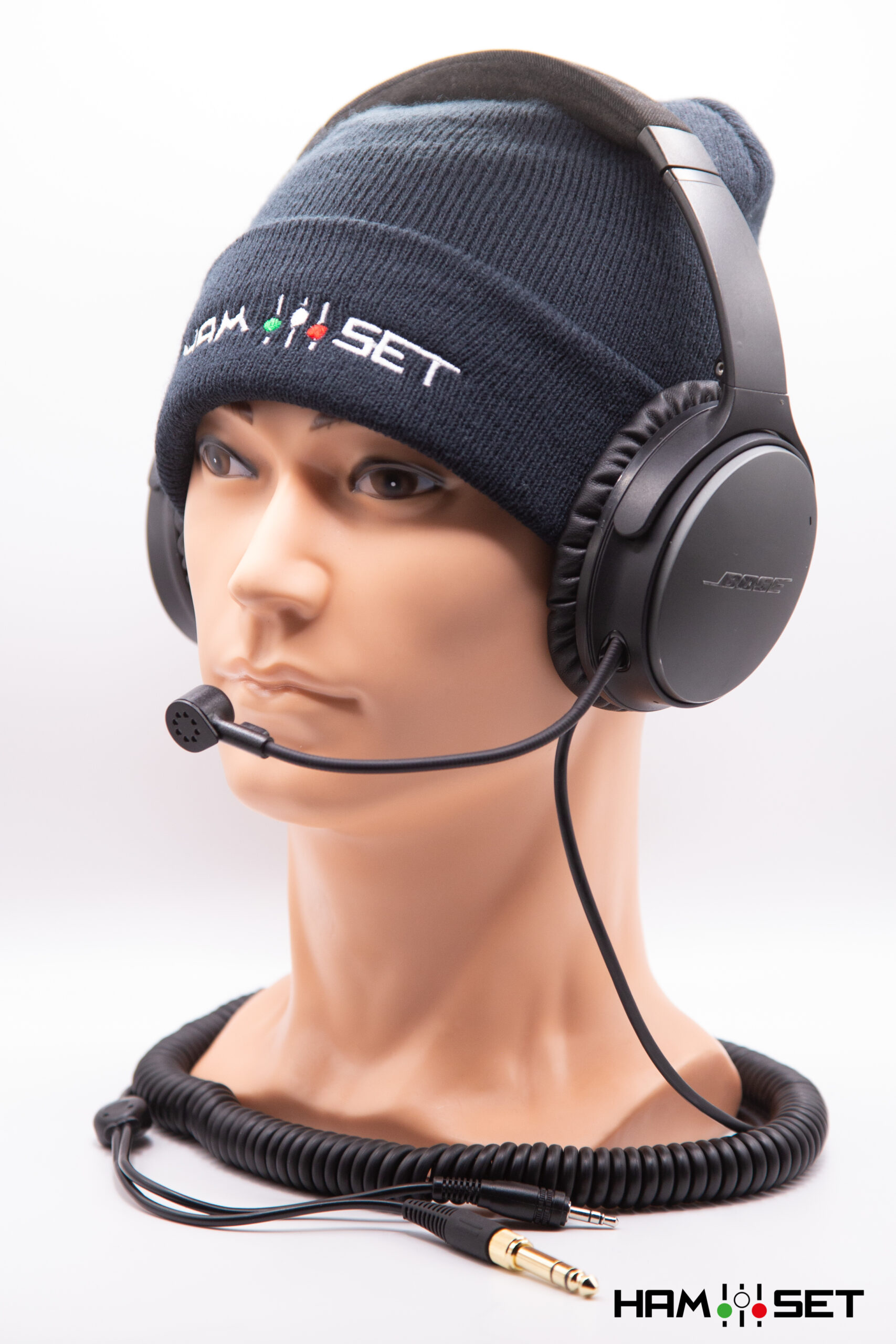
Bose® Noise Cancelling System
Bose’s renowned noise cancelling system is an advanced electronic technology designed to dramatically reduce external sounds. By using internal microphones and processors, it analyzes ambient noise in real time and cancels it by generating an opposite sound wave
How Active Noise Cancelling (ANC) Works in Bose QuietComfort Headphones
Bose QuietComfort headphones (such as QC25, QC35, and QC45) use an advanced electronic system called Active Noise Cancelling, designed to actively eliminate ambient noise before it reaches your ears. This is very different from passive isolation, which relies only on ear cushions to block out sound.
Internal and External Microphones: Each earcup contains two microphones:
An external mic that listens to the surrounding environment (like airplane engines, traffic, or air conditioning).
An internal mic that monitors what actually reaches your ear inside the cup.
This dual sensing system gives the headphones a more accurate picture of the noise, improving how it’s cancelled.
An external mic that listens to the surrounding environment (like airplane engines, traffic, or air conditioning).
An internal mic that monitors what actually reaches your ear inside the cup.
This dual sensing system gives the headphones a more accurate picture of the noise, improving how it’s cancelled.
The Brain of the System: The Processor
Inside the headphones, a small digital processor constantly receives input from the microphones.
It analyzes incoming noise and instantly generates an opposite sound wave, phase-shifted by 180 degrees.
This sound isn’t audible, but it’s used to cancel out the noise.
Inside the headphones, a small digital processor constantly receives input from the microphones.
It analyzes incoming noise and instantly generates an opposite sound wave, phase-shifted by 180 degrees.
This sound isn’t audible, but it’s used to cancel out the noise.
The Actual Noise Cancellation
The inverted signal is played through the headphone drivers, alongside your music or audio.
When the real noise wave meets the opposite wave, they cancel each other out.
This effect is called destructive interference, and it drastically reduces the amount of noise that reaches your ears.
The result? Low, steady noises (like engine hum or fan noise) are almost completely removed, while sharp or sudden sounds (like voices or keyboard clicks) are only reduced, not eliminated.
The inverted signal is played through the headphone drivers, alongside your music or audio.
When the real noise wave meets the opposite wave, they cancel each other out.
This effect is called destructive interference, and it drastically reduces the amount of noise that reaches your ears.
The result? Low, steady noises (like engine hum or fan noise) are almost completely removed, while sharp or sudden sounds (like voices or keyboard clicks) are only reduced, not eliminated.
Constant Adaptation
The system isn’t static — the processor checks and adjusts everything hundreds of times per second, adapting to how the ambient noise changes.
This makes the noise cancelling extremely effective even in dynamic environments like moving trains or busy offices.
The system isn’t static — the processor checks and adjusts everything hundreds of times per second, adapting to how the ambient noise changes.
This makes the noise cancelling extremely effective even in dynamic environments like moving trains or busy offices.
Aware Mode (QC45 Only)
The QC45 model includes a mode called Aware, which turns off noise cancellation and allows external sounds to pass through the microphones.
It’s useful when you need to stay aware of your surroundings or have a quick conversation without removing your headphones.
The QC45 model includes a mode called Aware, which turns off noise cancellation and allows external sounds to pass through the microphones.
It’s useful when you need to stay aware of your surroundings or have a quick conversation without removing your headphones.
Good to Know
The system only works when the headphones are powered on.
QC25 uses a AAA battery, while QC35 and QC45 have a built-in rechargeable battery (USB charging).
The headphones are designed to work even without playing music — you can use them just to cancel noise.
If you attach a boom mic to use them as a headset (e.g. for radio communication), noise cancelling has no effect on the microphone. It only acts on what you hear, so no technical adjustments are needed.
The system only works when the headphones are powered on.
QC25 uses a AAA battery, while QC35 and QC45 have a built-in rechargeable battery (USB charging).
The headphones are designed to work even without playing music — you can use them just to cancel noise.
If you attach a boom mic to use them as a headset (e.g. for radio communication), noise cancelling has no effect on the microphone. It only acts on what you hear, so no technical adjustments are needed.
Make Your Choice!
Our headsets can be customized to suit your specific needs. You can choose the type of microphone and cable you prefer, as well as the level of refurbishment, color, and the option to add your own callsign.
Your Perfect Match: Grade A, B, or C!
After Bose discontinued the QC 25 in 2020, these headphones are now available only second-hand, and we offer them refurbished in three grades and two color options (black/gray and white/beige)
Grade A: As good as new, with the best quality you can expect from a refurbished product. These headphones have passed all functional tests and are in excellent aesthetic condition with almost no signs of prior use. They come complete with the original box, carrying case, all accessories, and new ear pads.
Grade B: Also in excellent cosmetic condition, these headphones have passed all functional tests and are “like new,” with only slight signs of prior use. They include a carrying case and new ear pads, but do not come with the original cardboard box.
Grade C: In good cosmetic condition, these headphones have passed all functional tests but may show some signs of prior use. They are complete with a carrying case and new ear pads but lack the two rubber blue/gray bands on the speakers.
All headphones, regardless of grade, have been thoroughly tested, cleaned, and disinfected. Any worn or broken parts have been replaced or properly repaired before installing a new boom microphone and a 5-meter coiled RF-proof connection cable.
A true commitment to Refurbishing
We use only the highest-quality spare parts, ensuring that they look great and last for years to come. We avoid non-original and low-quality components, as they compromise the integrity and durability of the headset. Our commitment ensures that every headset maintains the quality and reliability of the original Bose® design.
We want only original parts!
At Ham-Set, we source genuine parts exclusively from other headsets, carefully selecting them for refurbishment. Damaged aluminum components are re-anodized and recolored to restore their original appearance. Ear pads are always replaced with a new pair, and both the cable and microphone are brand new. This rigorous process guarantees a product that feels and performs just like new.
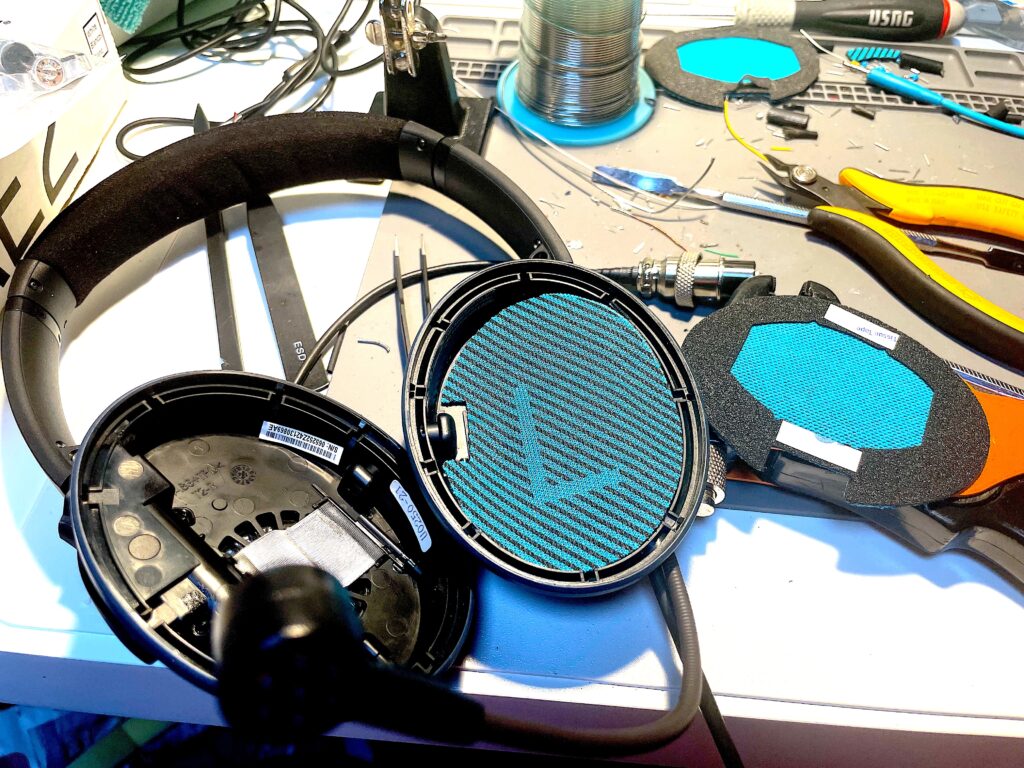
The Microphone That’s Right For You
Dynamic Capsule 600 Ohm
The Professional DYNAMIC MICROPHONE CAPSULE (not electret) does not need power to work and is the most compatible solution for any radio or accessory on the market today, including brand like Yaesu, Icom, Kenwood, Elecraft, Flexradio, Micro Keyer, etc. It’s the best solution for Multi Op contest Stations where many operators need to be plugged in a few seconds without changing any radio set up.
Just like the famous headphones with HC 4 – 5 – 6 capsules, they can be connected using only a simple adapter to the microphone plug without needing connection to the +5V.
Each dynamic microphone headset includes a small decoupling capacitor for safe connection to Icom radios or Microkeyer with voltage on the positive pin. Therefore, you will not need the connection cable with the capacitor inside, but just a simple adapter between radio’s microphone plug and 3.5mm jack.
Just like the famous headphones with HC 4 – 5 – 6 capsules, they can be connected using only a simple adapter to the microphone plug without needing connection to the +5V.
Each dynamic microphone headset includes a small decoupling capacitor for safe connection to Icom radios or Microkeyer with voltage on the positive pin. Therefore, you will not need the connection cable with the capacitor inside, but just a simple adapter between radio’s microphone plug and 3.5mm jack.
Electret Capsule 600 Ohm
The Professional ELECTRET MICROPHONE needs to be powered.
Its professional element ensures excellent vocal amplification, is noise-canceling and omnidirectional. The quality is undoubtedly better than the dynamic element: the voice is much richer in bass, the dynamic range is wider, and the output power is greater — but compatibility is certainly reduced.
Its ideal direct connection is with ICOM radios or with Micro Keyers that supply power on pin 1.
For all other brands, a special adapter cable is required to ensure proper powering of the microphone element — available upon request.
⚠️ Please note: Electret microphones are inherently much more susceptible to RF feedback compared to dynamic ones. If your station suffers from RF interference or audio feedback issues, we strongly recommend choosing the dynamic microphone element instead.
Its professional element ensures excellent vocal amplification, is noise-canceling and omnidirectional. The quality is undoubtedly better than the dynamic element: the voice is much richer in bass, the dynamic range is wider, and the output power is greater — but compatibility is certainly reduced.
Its ideal direct connection is with ICOM radios or with Micro Keyers that supply power on pin 1.
For all other brands, a special adapter cable is required to ensure proper powering of the microphone element — available upon request.
⚠️ Please note: Electret microphones are inherently much more susceptible to RF feedback compared to dynamic ones. If your station suffers from RF interference or audio feedback issues, we strongly recommend choosing the dynamic microphone element instead.
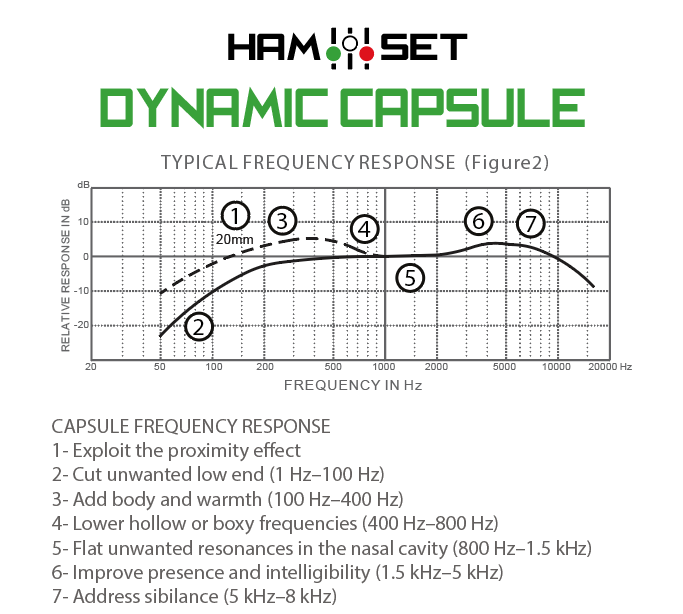
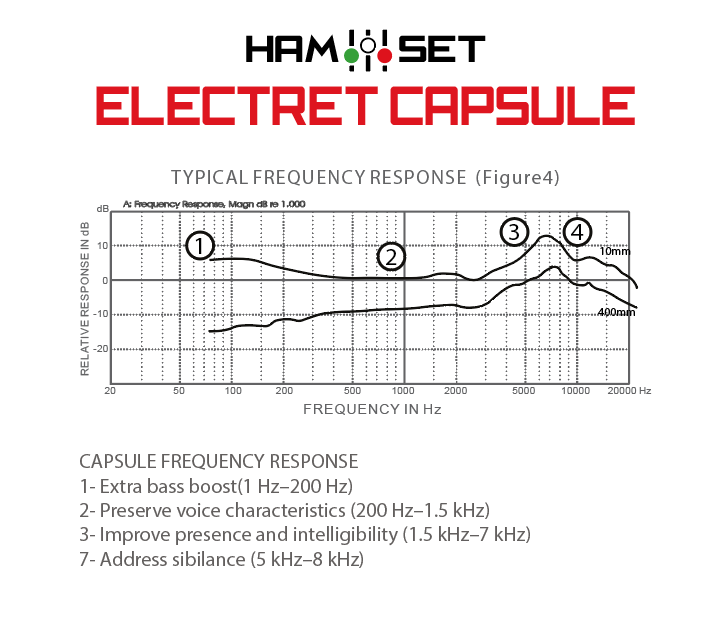
Dynamic Capsules: Proper Comparison Matters
HamSet vs. Heil Sound®
Magic Capsules Do Not Exist
In the world of amateur radio, there is often talk of “legendary” microphone capsules that seem to magically transform our transmissions and facilitate DXing. However, with all the modern technologies available—compression, DSP, equalizers—it is clear that the quality of transmission does not depend solely on the microphone.
In the past, when radios did not have compressors, processors, or equalizers, the microphone capsule was the only tool available to characterize modulation. Fortunately, modern microphones no longer have exaggerated curves like the +10 dB at 2 kHz of the Heil HC-4 or the +12 dB at 2.9 kHz of the Shure 444. They have flatter frequency responses, although each still retains its own characteristic curve, which we can adapt with proper equalization.
In the past, when radios did not have compressors, processors, or equalizers, the microphone capsule was the only tool available to characterize modulation. Fortunately, modern microphones no longer have exaggerated curves like the +10 dB at 2 kHz of the Heil HC-4 or the +12 dB at 2.9 kHz of the Shure 444. They have flatter frequency responses, although each still retains its own characteristic curve, which we can adapt with proper equalization.
Be Careful of the Differences: Ceramic or Dynamic Capsule?
The HC4 and HC5 capsules have become famous for their distinctive modulation. The HC4, known for its strongly accentuated response curve around 2100 Hz, was particularly appreciated by amateur radio operators for its ability to penetrate noise well, providing clear and incisive communication. Later, the HC5 replaced the HC4, offering slightly softer and less aggressive modulation but still effective for amateur radio use. Despite these capsules being considered “dynamic” by most of us radio operators, the truth is quite different. Just like the previous HC3, which Heil Sound itself had declared to be a ceramic capsule, the HC4 and HC5 are actually piezoelectric ceramic microphones. It has never been correct to compare them to real dynamic capsules, such as the HC6, which is indeed a dynamic capsule.
The Right Comparison
Unlike the HC4 and HC5, dynamic capsules like the HC6, HC7, and the Ham-set capsule have completely different construction and operation. While ceramic capsules are based on the piezoelectric principle, dynamic ones utilize a moving diaphragm associated with a coil immersed in a magnetic field. This generates a very different (generally lower) electrical signal with a wider and more natural frequency response compared to piezoelectric capsules.
The Ham-set capsule sounds very similar to the HC6 and should be evaluated in this light, rather than in relation to ceramic capsules. Achieving that type of sound curve, characteristic of ceramics and much loved by DXers for being very penetrating and low in bass, is absolutely possible with the correct bandwidth settings of the RTX, equalization, compression/processor, and mic gain.
The Ham-set capsule sounds very similar to the HC6 and should be evaluated in this light, rather than in relation to ceramic capsules. Achieving that type of sound curve, characteristic of ceramics and much loved by DXers for being very penetrating and low in bass, is absolutely possible with the correct bandwidth settings of the RTX, equalization, compression/processor, and mic gain.
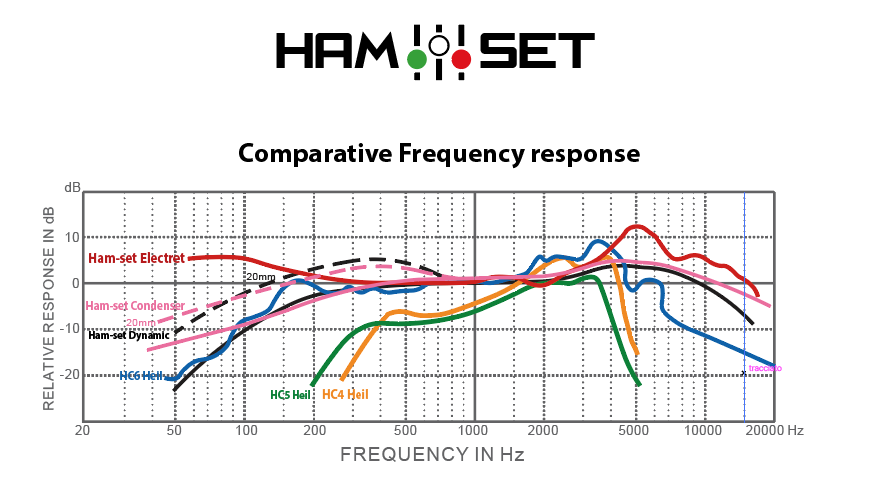
SSB: Proper Equalization
The main goal of equalization is to maintain a constant output level during both vowels and consonants. The dynamics of the human voice change: vowels tend to be stronger and more consistent, while consonants, which occupy the sibilant part of the spectrum (frequencies between 2000 and 4000 Hz), can sound weaker. This is why we need to focus on the mid-high frequencies to emphasize the consonants and reduce low frequencies that do not contribute to intelligibility.
Equalization and microphone settings are not only about making us “sound louder” but also about making our voice clear, understandable, and pleasant to listen to. Broadcasting is a medium where intelligibility is crucial: having a powerful signal is of no use if you cannot be understood by the listener. This is why it is important to take the time to optimally configure our Ham-Set dynamic capsule without excessively pushing the Mic Gain or compression controls. With the right adjustments, you can ensure that your capsule delivers high-quality modulation, comparable to—or even superior to—that of the “legendary” capsules of the past.
Equalization and microphone settings are not only about making us “sound louder” but also about making our voice clear, understandable, and pleasant to listen to. Broadcasting is a medium where intelligibility is crucial: having a powerful signal is of no use if you cannot be understood by the listener. This is why it is important to take the time to optimally configure our Ham-Set dynamic capsule without excessively pushing the Mic Gain or compression controls. With the right adjustments, you can ensure that your capsule delivers high-quality modulation, comparable to—or even superior to—that of the “legendary” capsules of the past.
Reducing Low Frequencies (below 200 Hz):
Low frequencies can create a “boomy” or “muddy” sound that does not help voice clarity in SSB. Attenuating these frequencies improves overall definition.
Action: Cut frequencies below 200 Hz by about -6 dB or more, depending on your voice. This will help prevent low frequencies from overloading the modulation.
Action: Cut frequencies below 200 Hz by about -6 dB or more, depending on your voice. This will help prevent low frequencies from overloading the modulation.
Emphasizing Mid-High Frequencies (between 2000 and 3000 Hz):
These frequencies are crucial for improving consonant understanding, which would otherwise risk being less audible. Slightly boosting these frequencies enhances intelligibility without making the sound too sharp or metallic.
Action: Increase mid-high frequencies between 2000 and 3000 Hz by +3 dB or +5 dB, as needed. This will help make consonants clearer and more present.
Action: Increase mid-high frequencies between 2000 and 3000 Hz by +3 dB or +5 dB, as needed. This will help make consonants clearer and more present.
Maintaining Balance in Mid Frequencies (500-1500 Hz):
Mid frequencies give body to the voice and are essential for keeping it natural and balanced. If we attenuate them too much, we risk having a modulation that sounds empty or too flat.
Action: Try to keep the mid frequencies balanced, making only slight adjustments to avoid a “nasal” effect.
Action: Try to keep the mid frequencies balanced, making only slight adjustments to avoid a “nasal” effect.
Limiting High Frequencies (above 3000 Hz):
Frequencies that are too high can create annoying sibilance and reduce listening comfort. A slight cut in this area can help make the sound softer.
Action: If you notice your voice is too shrill, slightly reduce frequencies above 3000 Hz.
Action: If you notice your voice is too shrill, slightly reduce frequencies above 3000 Hz.
Compressor and Mic Gain: Crucial Settings:
Once the microphone is equalized, it’s time to adjust Mic Gain and compression. The Mic Gain should be set so that the signal level is optimal without causing distortion. Start with a moderate value and gradually increase it until you reach a good modulation level. Do not overdo it with the Mic Gain: too high values can lead to a distorted or excessive signal.
Compression is equally important: it helps make the level of your modulation more consistent, limiting volume variations between the louder and softer parts of your speech. Start with light compression and increase it until you reach the desired ALC level, avoiding constant flickering of the ALC indicator.
Compression is equally important: it helps make the level of your modulation more consistent, limiting volume variations between the louder and softer parts of your speech. Start with light compression and increase it until you reach the desired ALC level, avoiding constant flickering of the ALC indicator.
Connect it to your Radio
Adapter cables are available for connection to your radios: Yaesu, Icom, Kenwood, Elecraft, FlexRadio, SunSDR… and more.
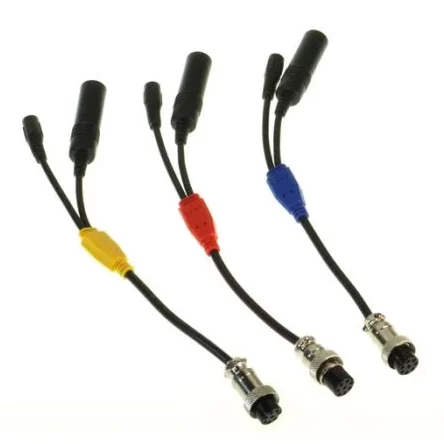
The Contest Station Choice
The Bose QC25 Hamset is becoming a must-have for major global contest stations. Their reliability and durability ensure intensive use, such as in a high-traffic contest station, without any issues.
The quality of Bose’s noise-cancelling system ensures perfect listening even in noisy and crowded environments, such as a room full of radio amateurs in the midst of a pile-up.
About the mic choice, contest stations prefer the use of the dynamic capsule just because it can be connected directly to all radios (including Icom) without the need for specific cables. It is preferred for its plug-and-play speed.
The tests for functionality, RF returns, and ergonomics were conducted at CN3A and II2S radio stations. Their teams use these headphones with the dynamic microphone capsule in all their contests.
The quality of Bose’s noise-cancelling system ensures perfect listening even in noisy and crowded environments, such as a room full of radio amateurs in the midst of a pile-up.
About the mic choice, contest stations prefer the use of the dynamic capsule just because it can be connected directly to all radios (including Icom) without the need for specific cables. It is preferred for its plug-and-play speed.
The tests for functionality, RF returns, and ergonomics were conducted at CN3A and II2S radio stations. Their teams use these headphones with the dynamic microphone capsule in all their contests.
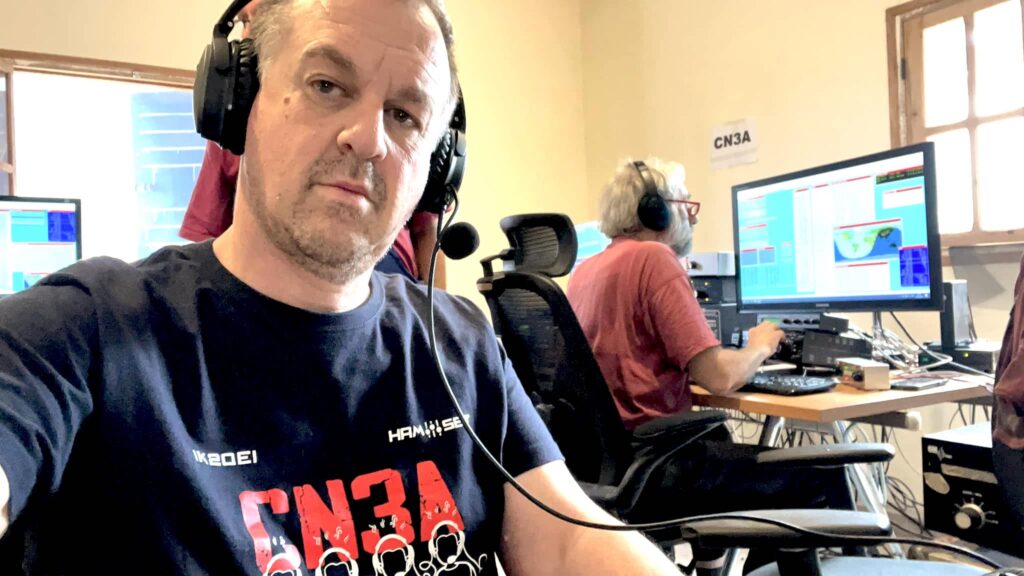
Bose QC25: Everything You Need to Know -Hidden Strengths and Common Flaws-
The Bose QC25 are among the most iconic noise-cancelling headphones ever made. Lightweight, durable, and incredibly comfortable, they’ve been a top choice for travelers, professionals, and — with the right microphone element — also for demanding radio operators. But like any great product, they’re not without weaknesses. Here’s a clear breakdown of what makes them exceptional — and what you should watch out for.
What Makes the QC25 So Special
Unmatched Comfort and Lightness
The QC25 are among the lightest over-ear noise-cancelling headphones in the world. You can wear them for hours — during long flights, work sessions, or contest operations — without fatigue. This makes them a top-tier choice for long listening or operating sessions.
Durable Fabric Headband
Unlike most modern headphones that use synthetic leather (which flakes over time), the QC25 headband is covered in woven fabric. This material doesn’t peel, crumble, or degrade — even after years of use — making it far more durable and comfortable in the long run.
The QC25 are among the lightest over-ear noise-cancelling headphones in the world. You can wear them for hours — during long flights, work sessions, or contest operations — without fatigue. This makes them a top-tier choice for long listening or operating sessions.
Durable Fabric Headband
Unlike most modern headphones that use synthetic leather (which flakes over time), the QC25 headband is covered in woven fabric. This material doesn’t peel, crumble, or degrade — even after years of use — making it far more durable and comfortable in the long run.
Known Issues and Design Weaknesses
Degrading Blue decorative rubber strip (see picture below)
One of the most frustrating issues with the QC25 is the soft blue rubber strip around the speaker enclosures. Over time, this material becomes sticky, deteriorates, and collects dirt, making the headphones look and feel unpleasant.
At HamSet, we fully clean and restore this area, replacing the original coating with a UV-resistant polymer that doesn’t degrade over time and maintains a clean, professional finish.
Speaker Rotation Weak Point
The ear cups rotate to a mechanical stop, which is useful for storage and portability. However, if forced beyond their intended limit, the mechanical stops can break.
Once broken, the speaker may continue to rotate freely — putting stress on the internal cable that carries audio to the driver, and eventually causing damage.
Advice: Always handle rotation gently. Normal use won’t cause damage, but excessive force can break the stops and compromise audio performance.
Loose Drivers: The “Ticking” Issue
In some QC25 units, the internal speaker (driver) is glued into the enclosure, but the adhesive can dry out — possibly due to minimal application during assembly. When this happens, the speaker may come loose and rattle inside the housing, producing a faint “clicking” sound when shaken or during audio playback.
This can cause unwanted vibrations and reduce sound quality.
One of the most frustrating issues with the QC25 is the soft blue rubber strip around the speaker enclosures. Over time, this material becomes sticky, deteriorates, and collects dirt, making the headphones look and feel unpleasant.
At HamSet, we fully clean and restore this area, replacing the original coating with a UV-resistant polymer that doesn’t degrade over time and maintains a clean, professional finish.
Speaker Rotation Weak Point
The ear cups rotate to a mechanical stop, which is useful for storage and portability. However, if forced beyond their intended limit, the mechanical stops can break.
Once broken, the speaker may continue to rotate freely — putting stress on the internal cable that carries audio to the driver, and eventually causing damage.
Advice: Always handle rotation gently. Normal use won’t cause damage, but excessive force can break the stops and compromise audio performance.
Loose Drivers: The “Ticking” Issue
In some QC25 units, the internal speaker (driver) is glued into the enclosure, but the adhesive can dry out — possibly due to minimal application during assembly. When this happens, the speaker may come loose and rattle inside the housing, producing a faint “clicking” sound when shaken or during audio playback.
This can cause unwanted vibrations and reduce sound quality.
If you own a pair of QC25 and want to restore them, modify them for ham radio use, or simply bring them back to life — HamSet is here to help.

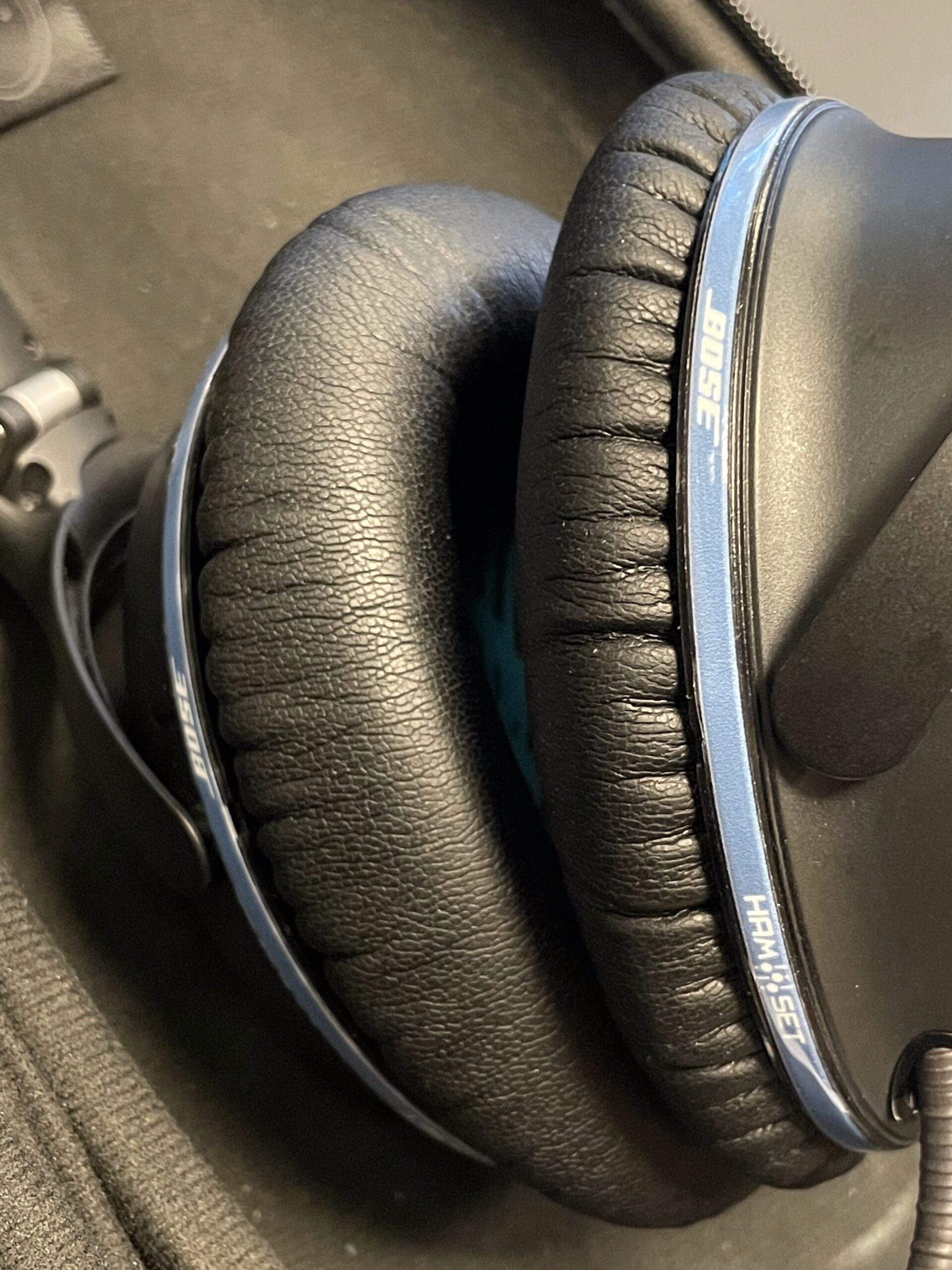
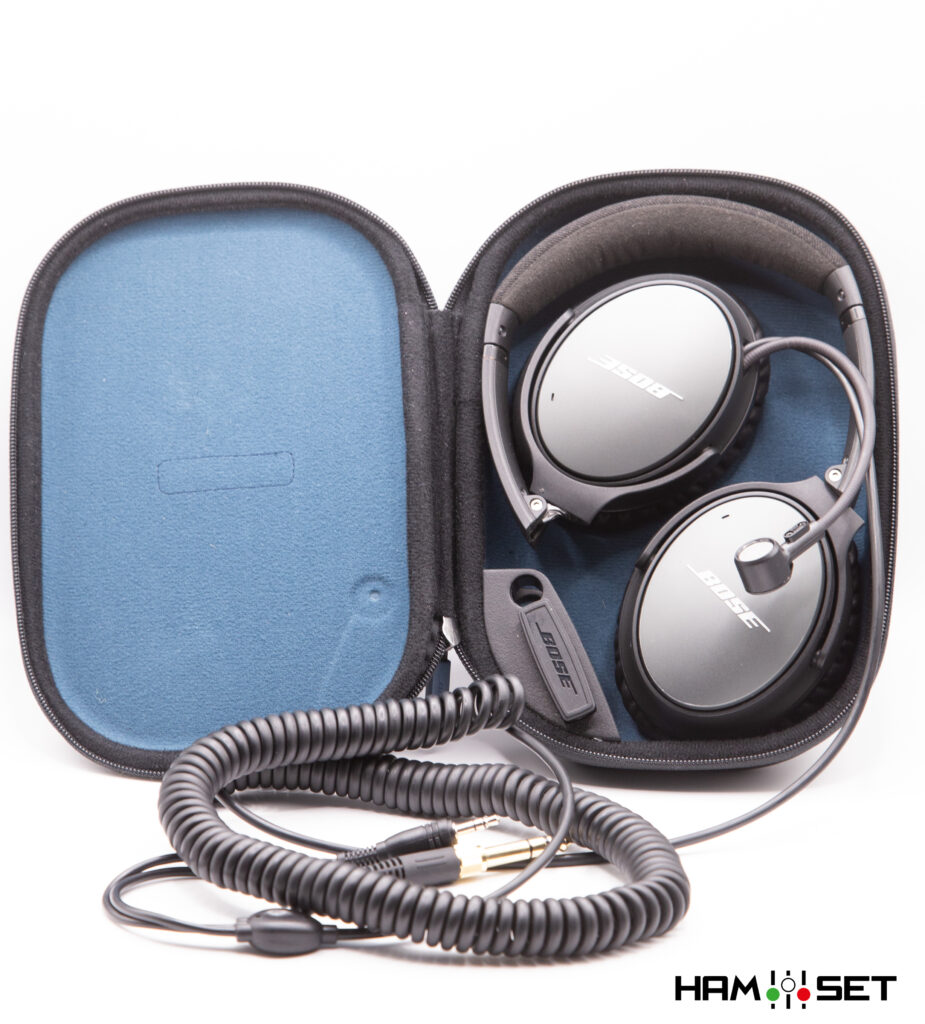
Specifications:
Headphones
Speaker: 40mm
Impedance: 32 Ohm
Frequency response: 20 – 20,000 Hz
Battery life with Noise canceller on: 35 hours
The headphone also works without battery with Noise canceller turned off.
Dynamic range: -54dBFS
Connection: 3.5mm stereo male jack+ 6.3mm adapter


Microphone
Capsule: Dynamic
Impedance: 600 Ohm
Polar Pattern: Cardioid
Sensitivity: -60 dBV/Pa (1mW)
Frequency Response: 150 – 10,000Hz
Max SPL: 136dB SPL
Connection: 3.5mm male jack
Frequently asked question
Why should I choose the Bose QC25 over the QC35, QC45, or QC SE, which are also Bluetooth?
The QC25 is a wired model with no Bluetooth module, making it ideal for multi-operator SSB contests where simplicity, reliability and low noise are key. It avoids battery drain during long runs and eliminates feedback or latency issues common in wireless systems. In contrast, QC35/45/SE models have very limited internal space, making it difficult to install a permanent boom mic without compromise. If you prefer one of these newer models, HamSet now offers a professional clip-on mic kit for QC35, QC45 and QC SE, specifically designed for contest use.
I found a cheap boom microphone online that attaches to the QC35/45/SE. Will it work?
Some kits may appear compatible, but they have significant limitations:
1-The included microphone is typically a low-grade electret capsule with incorrect impedance for ham radios.
2-The cable is unshielded and uses a shared ground for mic and audio, causing audible feedback (your own voice leaks into the headphones).
3-A 4-pin to dual 3-pin adapter is required for standard radio setups.
By replacing the capsule with a quality one, you may achieve decent results, but the cable remains a serious problem. Additionally, electret capsules lack the plug-and-play compatibility of dynamic mics, which is crucial in multi-op contest stations where switching operators must not require radio reconfiguration. The HamSet clip-on solution, with a professional-grade dynamic or electret capsule and a shielded, properly wired cable, ensures full compatibility and audio quality without compromises.
1-The included microphone is typically a low-grade electret capsule with incorrect impedance for ham radios.
2-The cable is unshielded and uses a shared ground for mic and audio, causing audible feedback (your own voice leaks into the headphones).
3-A 4-pin to dual 3-pin adapter is required for standard radio setups.
By replacing the capsule with a quality one, you may achieve decent results, but the cable remains a serious problem. Additionally, electret capsules lack the plug-and-play compatibility of dynamic mics, which is crucial in multi-op contest stations where switching operators must not require radio reconfiguration. The HamSet clip-on solution, with a professional-grade dynamic or electret capsule and a shielded, properly wired cable, ensures full compatibility and audio quality without compromises.
Dynamic or Electret Microphone? What’s the difference and which should I choose?
A dynamic microphone does not require external power and connects directly to the mic input of most ham radios. It is extremely compatible, directional (cardioid pattern), and works best when placed just a few centimeters from the mouth, aligned correctly. It delivers natural audio and can be fine-tuned using the radio’s equalizer. Dynamic capsules are ideal in contest stations, especially multi-operator setups, because they ensure consistency and immediate compatibility across different radios without needing to adjust mic gain or power settings.
An electret microphone, by contrast, requires +5V phantom power (available on many Icom radios and interfaces like MicroKeyer) and has a very different internal architecture. The capsule provided in HamSet electret models is omnidirectional, meaning it picks up sound from all directions, with less isolation from ambient noise compared to the cardioid dynamic capsule. This makes it less suitable for noisy environments such as contest stations or multi-op setups, where cross-talk or background speech can be captured.
However, the electret capsule provides:
– Higher sensitivity,
– Greater amplification,
– A richer and more colorful sound,
making it ideal for voice communication with a broad tonal range, streaming, or single-operator casual use. The downside is lower compatibility: many transceivers don’t support electret capsules natively and require special cabling or interface adjustments. In addition, since the electret signal is more “colored”, it’s harder to get a neutral or flat profile without proper equalization. Unlike dynamic mics, electret systems are more sensitive to cable shielding and power stability; poorly shielded cables may pick up noise, hum, or result in RF feedback.
Compatibility with Yaesu, Kenwood, Elecraft and other brands is possible, but only with the correct adapter cable, which HamSet can provide upon request.
For maximum flexibility and ease of use in contest environments, the dynamic capsule remains the preferred choice. The electret is recommended only when a more present, full-bodied sound is desired, and in controlled or quiet environments.
An electret microphone, by contrast, requires +5V phantom power (available on many Icom radios and interfaces like MicroKeyer) and has a very different internal architecture. The capsule provided in HamSet electret models is omnidirectional, meaning it picks up sound from all directions, with less isolation from ambient noise compared to the cardioid dynamic capsule. This makes it less suitable for noisy environments such as contest stations or multi-op setups, where cross-talk or background speech can be captured.
However, the electret capsule provides:
– Higher sensitivity,
– Greater amplification,
– A richer and more colorful sound,
making it ideal for voice communication with a broad tonal range, streaming, or single-operator casual use. The downside is lower compatibility: many transceivers don’t support electret capsules natively and require special cabling or interface adjustments. In addition, since the electret signal is more “colored”, it’s harder to get a neutral or flat profile without proper equalization. Unlike dynamic mics, electret systems are more sensitive to cable shielding and power stability; poorly shielded cables may pick up noise, hum, or result in RF feedback.
Compatibility with Yaesu, Kenwood, Elecraft and other brands is possible, but only with the correct adapter cable, which HamSet can provide upon request.
For maximum flexibility and ease of use in contest environments, the dynamic capsule remains the preferred choice. The electret is recommended only when a more present, full-bodied sound is desired, and in controlled or quiet environments.
Can I modify my QC25 headset? What does the process involve?
Yes, you can send your QC25 headset to HamSet for a complete professional conversion. The service includes cleaning, earpad replacement, installation of the microphone (dynamic or electret), and a shielded cable with the correct termination for your radio. The modification is permanent and costs €120, excluding shipping. You can request it directly via our website.
The HamSet mic capsule doesn’t seem to have the same punch as my old Heil HC-4. Why?
The capsule used in HamSet headsets is a dynamic cardioid element. Like all dynamic mics, it must be positioned close and directly in front of the mouth to deliver optimal gain and articulation. Its compact and lightweight design prioritizes comfort and flexibility but requires precise alignment to the sound source.
Compared to the Heil HC-4 or HC-5 (which are ceramic, not dynamic), the standard HamSet capsule is much more balanced and natural in its frequency response. The HC-4, in particular, is strongly mid-high boosted, with a complete cut of low frequencies, designed to punch through pileups at the cost of tonal richness. The HamSet dynamic mic is closer in sound to a Heil HC-6, offering a flatter, more neutral response that can be easily enhanced via your radio’s EQ.
If you’re looking for a warmer, more full-bodied voice, especially in streaming or casual QSOs, the HamSet electret capsule is an excellent alternative—ideal for Icom, SunSDR, FlexRadio and similar systems that support powered microphones.
However, for those who prefer a “plug-and-play” DX profile without using EQ settings or audio processors, a new capsule is coming soon: the HamSet DX capsule, engineered to emulate the aggressive HC-4-style modulation, with strong emphasis on the high frequencies and a full cut of the lows.
It will be ideal for radios without built-in equalizers or for operators who want a ready-to-use, sharp and penetrating sound specifically tailored for DX pileups and contesting.
Compared to the Heil HC-4 or HC-5 (which are ceramic, not dynamic), the standard HamSet capsule is much more balanced and natural in its frequency response. The HC-4, in particular, is strongly mid-high boosted, with a complete cut of low frequencies, designed to punch through pileups at the cost of tonal richness. The HamSet dynamic mic is closer in sound to a Heil HC-6, offering a flatter, more neutral response that can be easily enhanced via your radio’s EQ.
If you’re looking for a warmer, more full-bodied voice, especially in streaming or casual QSOs, the HamSet electret capsule is an excellent alternative—ideal for Icom, SunSDR, FlexRadio and similar systems that support powered microphones.
However, for those who prefer a “plug-and-play” DX profile without using EQ settings or audio processors, a new capsule is coming soon: the HamSet DX capsule, engineered to emulate the aggressive HC-4-style modulation, with strong emphasis on the high frequencies and a full cut of the lows.
It will be ideal for radios without built-in equalizers or for operators who want a ready-to-use, sharp and penetrating sound specifically tailored for DX pileups and contesting.
Can I use the HamSet clip-on mic system on my QC35/45/SE without modifying the headphones?
Yes. The HamSet clip-on mic kit for QC35/45/SE is completely non-invasive: it clips securely to the earcup without damaging the surface, and is fully removable. It includes a professional dynamic or electret capsule and a shielded dual-channel cable, ready to connect to your radio.
Is the mic removable or swappable?
In the clip-on versions, yes. You can choose between dynamic and electret capsules depending on your setup, and replace the mic boom independently if needed. In QC25 hardwired conversions, the capsule is fixed and optimized for the chosen setup.
Do I need an interface to use the HamSet headset with my radio?
No. All HamSet headsets are designed to connect directly to your radio’s mic input, either via dynamic wiring or electret with adapter. No additional interface is required for basic operation.
Can I get a version with a condenser (electret) mic for more audio presence and depth?
Yes. HamSet offers the QC25 with a professional electret microphone, designed for Icom and other radios with bias power. For Yaesu, Elecraft, Kenwood and others, we can provide the correct adapter cable. This version delivers more gain, detail and warmth in voice transmission, especially useful in non-contest use, streaming, or for operators who want maximum audio presence.

